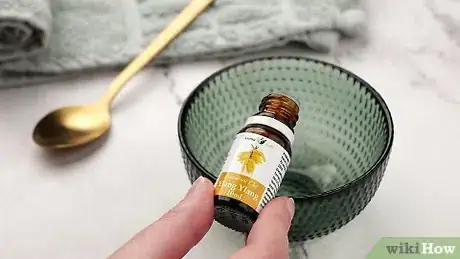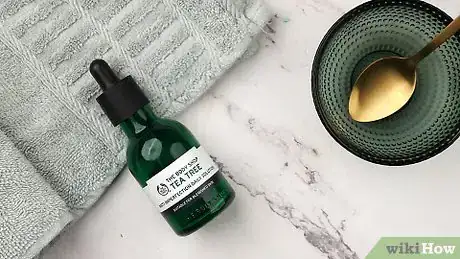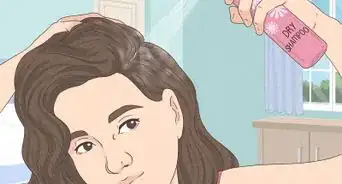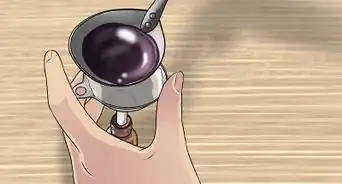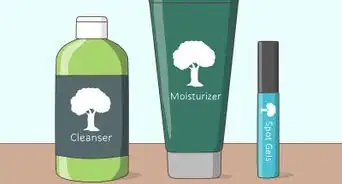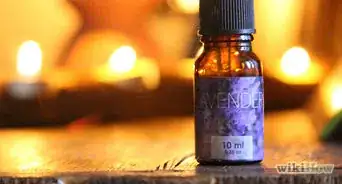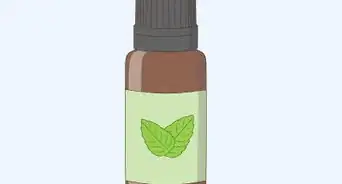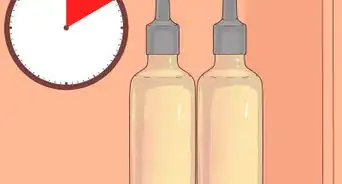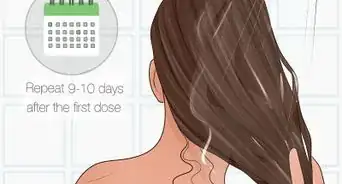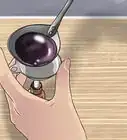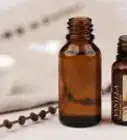This article was co-authored by Marius Morf. Marius Morf is the Salon Owner of PREP in San Francisco, CA. Marius owns and operates 5 salons and has over 10 years of experience in the industry. Marius and his “salonbershops” serve all genders and ages and specialize in cuts, coloring, and general hair care.
This article has been viewed 176,727 times.
Essential oils are great for adding soothing or revitalizing fragrances to your shampoos, and they often smell great! Some oils are even known to have beneficial or medicinal properties. Some essential oils are good for making your hair shiny, some are nourishing and moisturizing, and some may even promote hair growth and prevent dandruff. You can play around with different essential oil combinations, or you can follow established recipes. It’s always important to store your shampoo properly after you mix in the oils, so that they don’t deteriorate.
Steps
Choosing the Right Oils
-
1Pick oils for normal hair. Essential oils have different fragrances and properties, so some are better for treating different hair types and hair care problems than others. If you have normal hair that isn't prone to dryness and isn't overly oily, some of the best essential oils for your hair include:
- Rosemary
- Lavender
- Geranium
- Lemon
- Clary Sage
- Cedarwood
- Thyme
- Chamomile
-
2Manage oily hair. There are a variety of essential oils that help with oily hair, because they either help slow oil production or are simply better at cleaning the scalp of oil. If you have oily hair, experiment with oils such as:
- Lemongrass
- Ylang-ylang
- Cedarwood
- Lemon
- Tea Tree
- Rosemary
Advertisement -
3Treat dry hair. Dry hair is characterized by tangles, split ends, and dullness. It can be caused by a lack of oil from the scalp, too many damaging hair treatments, and overuse of heat tools and hair styling products. You can add some moisture back to your hair with oils such as:
- Geranium
- Lavender
- Rosemary
- Sandalwood
- Cedarwood
- Peppermint
- Tea tree
- Argan oil
-
4Pick oils to help with minor dandruff. Dandruff can be caused by a number of different things, but there are a few essential oils that can help with minor flakes and itchy scalps.[1] These include:
- Tea tree
- Lemongrass
Adding the Oils
-
1Do a patch test. This is especially important if you're using a new essential oil for the first time, because you want to make sure you aren't allergic to it. To do a patch test:
- Mix three drops of the oil you plan to use with ½ teaspoon (3 ml) of carrier oil, such as jojoba, almond, or walnut oil.
- Place a couple drops on your inner forearm, just below your elbow. Cover the area with an adhesive bandage.
- Keep the bandage on and don’t wash the area for 48 hours. After that time, remove the bandage and check for irritation, such as redness, itching, blisters, or swelling. If none of these symptoms appear, you aren't allergic to the oil and it’s safe to use in your shampoo.[2]
- Some essential oils shouldn’t be used on children under five, including basil, camphor, cinnamon, clove, eucalyptus, lavender, lemongrass, thyme, bergamot, nutmeg, peppermint, rosemary, tea tree, wintergreen oils and sage.[3]
- Be careful not to get essential oils in your eyes, as they can cause irritation.
-
2Gather your supplies. To add essential oils to your shampoo, you will need a few things on top of your shampoo and the essential oils of your choice. Also gather a measuring cup, funnel, small mixing bowl, and dark glass or plastic bottle with a tight fitting lid.
- Store your shampoo and essential oil mixtures in a dark bottle with a tight lid because light, heat, and oxygen can destroy the aromas and properties of the oils.[4]
- Always put the lid back on tightly after you’ve used essential oils or your shampoo.
- Some essential oils in their concentrated forms can degrade plastics, so you should always store concentrated oils and blends in glass bottles.
-
3Portion out the shampoo. A good rule of thumb is to use about 20 drops of essential oil per ½ cup (120 ml or 4 oz) of shampoo. Measure out the shampoo and pour it into your mixing bottle. Stick the funnel into the mouth of the mixing bottle before pouring in the shampoo to prevent spills.[5]
- Start with ½ cup (120 ml or 4 oz) of shampoo if you haven't done this before, just in case you don’t like the smell or effect of the oils you use.
- If you want to use a full bottle of shampoo, look at how many ounces or milliliters are in the bottle to determine how many drops of oil to use. You can add oils directly to the bottle of shampoo if you're adding the same oils to the entire bottle.
-
4Combine your oils. In a small mixing bowl, blend about 20 drops of different essential oils, or 20 drops of a single oil if you prefer. Stir them with a spoon or swirl them around the bowl to blend them together, and then smell the oil combination.
- Remember to increase the amount of oil you use based on the quantity of shampoo. Many shampoo bottles contain between 12 and 16 ounces (355 to 473 ml) of shampoo, so if you're adding essential oils to an entire bottle, you'll need between 60 and 80 drops of oil.
-
5Add the oils and stir. When you're happy with the result of your essential oil mixture, pour it into the mixing bottle with the shampoo. Use the funnel to avoid spills.
- Stir the oils into the shampoo if you have a long and narrow stir stick or spoon that will fit into the bottle. Otherwise, give it a gentle shake.
- Always shake the shampoo before using it, to redistribute the oils throughout the shampoo.
Blending Oils
-
1Make a nourishing blend for unhealthy hair. Whether your problem is dryness, flakes, or damage, you can make an essential oil blend for your shampoo that will help to moisturize and nourish your hair, and fight flakes. A few good recipes are:
- 10 drops each of lemon, rosemary, tea tree, and lavender, mixed with 1 ¼ cup (300 ml) of shampoo.
- 20 drops of clary sage, plus 15 drops each of wild orange and lavender, mixed with about 1 cup (240 ml) of shampoo.
- 10 drops each of lavender, cedarwood, rosemary, and peppermint, mixed with 1 cup (240 ml) of shampoo.
-
2Select oils to make your hair smell great. Most essential oils smell great on their own, but blending them together can be tricky. A few essential oils that are good for hair and smell wonderful include basil, bergamot, lavender, ylang-ylang, and mint. For a few essential oil blends that smell fantastic and promote healthy hair, try:
- 25 drops of lemongrass, 10 drops of lemon, and 15 drops of lavender, mixed with 1 ¼ cup (300 ml) of shampoo.
- 30 drops of wild orange and 20 drops of lavender, mixed with 1 ¼ cup (300 ml) of shampoo.
- 30 drops of lavender and 20 drops of peppermint, mixed with 1 ¼ cup (300 ml) of shampoo.
-
3Make an all-purpose essential oil mix. There are certain oils that are great for all-purpose hair care, and that are suitable for any hair type, and these include rosemary and lavender. To make a great-smelling essential oil blend for healthy hair, mix together:[6]
- 40 drops Lavender
- 10 drops Rosemary
- 5 drops Ylang Ylang
- 1 ½ cups (360 ml) of shampoo
References
- ↑ https://www.webmd.com/skin-problems-and-treatments/ss/slideshow-dandruff
- ↑ http://www.takingcharge.csh.umn.edu/explore-healing-practices/aromatherapy/are-essential-oils-safe
- ↑ https://www.wabe.org/essential-oils-popular-but-can-pose-risk-to-kids-georgia-health-news-reports/
- ↑ https://ift.onlinelibrary.wiley.com/doi/full/10.1111/1541-4337.12006
- ↑ http://aromaweb.com/recipes/rcrshamp.asp
- ↑ http://aromaweb.com/recipes/rcrshamp.asp
About This Article
Adding an essential oil to your regular shampoo is a great way to strengthen your hair and make it smell nice. For a good balance, you’ll want about 20 drops of oil per 4 ounces of shampoo. Pour your shampoo into a measuring cup so you can get the ratios just right. You’ll need to mix the oil and shampoo together with a spoon, then pour the mixture into a bottle using a funnel. For normal or oily hair, use a fragrant oil like rosemary, cedarwood, or lemon. If you get dry hair, sandalwood, peppermint, and tea tree can help to moisturize it. For more tips, including how to do a patch test with a new essential oil, read on!

